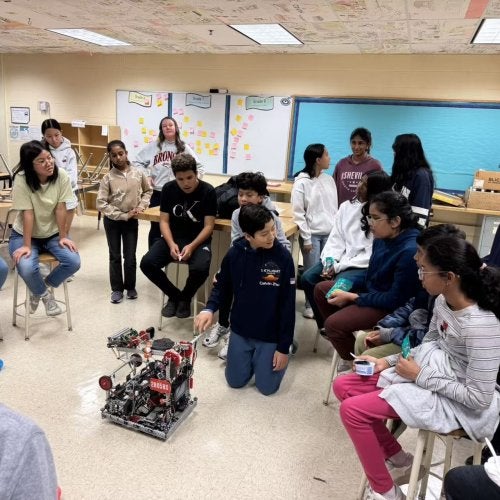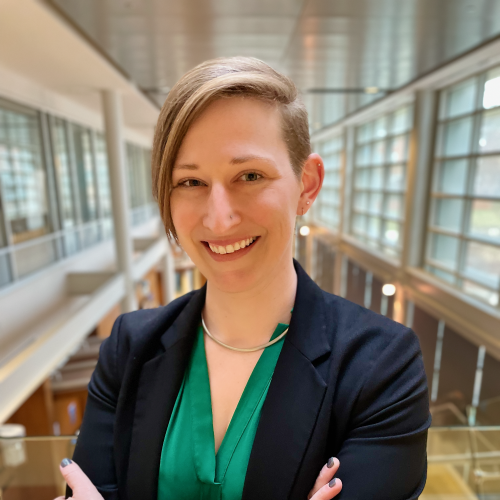

To tell real vs false online, high schoolers receive professional fact-checking training

The digital world provides access to high quality information, but it also hosts inaccuracies and falsehoods that can be difficult to identify, as evidenced by social media controversies over inaccurate political messaging.
At the University of Maryland College of Education, researchers are reexamining how students are taught to evaluate the trustworthiness of digital information. By teaching high schoolers techniques used by professional fact-checkers, COE researchers aim to help students develop effective evaluation strategies. The study, which showed an improvement in students’ ability to evaluate information after learning fact-checking strategies, was published by Computers and Education.
“Young people say that social media is their top source for news now,” said study author Sarah McGrew of COE’s Department of Teaching and Learning, Policy and Leadership.
“There are so many amazing things about the access to information. This study is about helping students develop skills to find reliable information so they can take advantage of the wealth of digital information,” she said.
The study, part of Dr. McGrew’s dissertation research at Stanford University, offers an alternative to current approaches to learning how to evaluate online information, which are often problematic or not taught at all in schools, Dr. McGrew said. Partly, this comes down to the rapid development of the internet and related technology, with which the education system has struggled to keep pace.
One of Dr. McGrew’s earlier studies, with Sam Wineburg of Stanford University, compared how well professional fact-checkers, university history professors and university freshman evaluated the accuracy of digital content. Overall, the fact-checkers outperformed the other groups.
“The fact-checkers had a distinct approach to evaluating information and a set of strategies to very efficiently and effectively find sources that they trusted online,” Dr. McGrew says.
One main difference, Dr. McGrew points out, is that the fact-checkers read laterally, meaning that when they encountered an unfamiliar website, they would immediately leave the website to research the site using outside sources. Dr. McGrew envisioned an intervention-based design that embedded the fact-checker’s strategies in a core content area class in schools.
Working at a high school in California, Dr. McGrew implemented the intervention with a teacher to 68 students in three AP history classes. The students received eight fact-checking lessons over the course of a semester and were challenged to evaluate online content, including social media posts and websites, in testing before and after the intervention.
The tasks asked students to examine where the digital information came from, whether the information was supported by outside sources and to use lateral reading strategies in evaluating the content.
For instance, the social media task involved pre-test evaluation of an image claiming that the Fukushima nuclear disaster caused abnormalities in nearby flower populations and a post-test evaluation of whether another image of an art installation provided strong evidence about the conditions for children in Syria.
Another more complex task required the students to evaluate contemporary claims about historical figures. In pre-testing, the students evaluated claims that Cesar Chavez—the United Farm Workers co-founder—opposed Mexican immigration to the United States, and in post-testing, claims that Margaret Sander—the Planned Parenthood founder—supported euthanasia.
Compared with the pre-tests, student performance in the majority of post-tests showed positive movement of using fact-checking strategies to evaluate online sources and evidence. On the historical claim research, for instance, 71% of students provided a relevant explanation about the trustworthiness of a source they used to inform why they agreed or disagreed with the claims, compared with only 25% of students in pre-testing.
“On the post-test a lot of kids raised those critical questions about the evidence,” Dr. McGrew says.
A number of the students showed evidence of using lateral reading skills, too, with more three times the students successfully reading laterally in post-testing than on the pretests. Even the students who didn’t successfully read laterally showed signs of improvement by looking at the ‘about page’ on a website.
“I read that still as movement because they’re caring about what the source is, but haven’t yet learned that they need to get out of the site,” Dr. McGrew said.
As phones and computers give unparalleled access to information, evaluating the validity of that information is important for making personal, community and political decisions, and it’s the responsibility of schools to teach students strategies for navigating digital information, Dr. McGrew says.
“If we’re turning to the internet for that information, we have to be able to evaluate it,” she says. “I think as part of the civic mission of schools, it’s our responsibility to help kids learn how to deal with this and take advantage of the strengths of having access to so much information.”
Dr. McGrew is an assistant professor in the Department of Teaching and Learning, Policy and Leadership. Her research interests include digital literacy, educational technology and teacher education.


